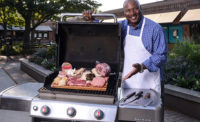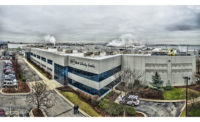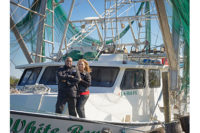Nestled in the valley of the Truckee River, near Lake Tahoe in “The Biggest Little City in the World,” versatile protein processor Sierra Meat & Seafood quietly has been making a name for itself in the greater Sierra Nevada region, focused sharply on adding business throughout the United States at a manageable pace and adding value to the proteins supplied by its vertically integrated specialty-meats business.
The company, established in 1935, has made its way over the years by pouncing on opportunities — whether processing or distribution-related — converting them into successful ventures, and occasionally moving on to additional pursuits. The company history is peppered with acquisitions and innovation, but also with divestitures of facilities as well as the relocation of the company headquarters to its current location in Reno, Nev., in 2001. Roughly five years ago, the company sold its California processing facilities, setting up the Reno facility to focus on the northern Nevada foodservice business, a growing private-label steak-cutting business and growth in the popularity of specialty meats.
Chris Flocchini, third-generation family member and president/CEO of Sierra Meat & Seafood, wouldn’t call the corporate modifications over the years a “reset” of priorities, because the core foodservice, distribution and ranching businesses did not change — nor were the modifications based on whimsy or fad-chasing. Instead, they have been reflective of a growth strategy based on longer-term industry trends, he says.
“We could see on the bison, venison and other specialty meats business that there was a growing foodservice and retail interest in them, with the consumer interest in alternative proteins at an all-time high,” he explains.
In 2014, Sierra Meat & Seafood began to bolt on acquisitions again — taking its first step into the Wagyu beef business, making a deal with a vertically integrated company that wanted to get out of the processing portion of the business. Sierra Meat & Seafood purchased the cattle on feed (approximately 1,300 head, Flocchini says), and created the Durham Ranch Wagyu brand. Prior to this acquisition, Sierra Meat & Seafood had only dabbled a little bit in selling Wagyu products.
The next big business maneuver came via the acquisition of The Sausage Factory in Carson City, Nev., in 2015. Sierra Meat & Seafood already had acquired the distribution business owned by The Sausage Factory years prior, and the opportunity arose to purchase the sausage-processing operation as well last year. Flocchini says the timing was right to work with Joe Tonino, owner of The Sausage Factory, to get a deal done.
“We saw an opportunity to grow our branded, handcrafted sausage and deli meats within our existing 100 national foodservice distributor base, and also give us a value-added product line to enter retail,” Flocchini says. The line was rebranded with the family name — a move that goes hand-in-hand with the company’s expanded strategy to be more visible in the local communities it serves. Flocchini Family Provisions products are distributed throughout the Sierra Nevada region and in some national markets (including placement of the tri-tip sausage at Disneyland this summer and other products at select retail stores in Indiana and Ohio), and the company’s next step is to increase distribution in the Bay Area and beyond.
Flocchini says the Carson City plant was in great shape when Sierra Meat & Seafood swooped in, and there is potential for growth of the product line within the walls of the facility as it currently stands. He adds that the team, led by Steve Church, general manager, and Brandon Bell, production manager, is trusted to lead the brand to greater heights.
“We can triple the business we’re doing now,” he says. “We could do more than 100,000 pounds a week within the existing infrastructure with the existing equipment, running full shifts.”
As with any acquisition, investment needed to be made, and Flocchini says capital expenditures will continue in Carson City, “to incrementally improve the facility and equipment to put out an even better product and be more efficient.”
Capital investment hasn’t been limited to the Carson City plant, either. Sierra Meat & Seafood’s Reno facility is adding approximately 4,000 square feet of processing footprint by cutting into a large dry-storage area. The new space will house a segregated grinding room, Flocchini says.
“We want to pull grinding out of the main room for food safety and so that we can process more grinds,” he says. “We want to promote more one-pound retail bricks for our specialty meats, and we really want to have that process isolated and better controlled, put in additional interventions and have a nice, controlled atmosphere.”
According to Flocchini, initial estimates indicate that the new grinding room should allow Sierra Meat & Seafood to produce about four times more burgers and ground products (fresh and frozen) than the company is producing now, shoehorned into the steak-cutting room. Additionally, moving the grinding operation off the cutting room floor creates open capacity for steak-cutting expansion.
While production capacity may not stand in the way of skyrocketing success, it should be noted that the specialty-meats supply and the company’s own strategic plans will allow more control over the growth curve.
“There’s only so much bison, and the industry can only grow at a certain pace — also, there’s a supply shortage right now,” Flocchini explains. As a result, the company plans to add value to its specialty-meats line by creating some innovative products but also by pushing its Durham Ranch brand heavily.
“We’re trying to be the first to brand these specialty meats and have people identify the Durham Ranch brand as something unique that they’d prefer to have over anything else,” Flocchini says. “We actually own the ranch, we raise the bison and we’ve been doing it for 50 years now; also, we own 2,000 head of Wagyu cattle and have been partners with deer farmers in New Zealand for 30 years; nobody in the industry has really done a good job of [telling a story like that].”
The same strategy of controlling the ascent applies to Flocchini Family Provisions as well. Flocchini says the company isn’t interested in flooding the market with lesser-quality product in order to shoot up the ranks in a short period of time.
“It’s not a commodity, and we don’t want to treat our product that way. It is artisanal; our sausage is handmade. So we don’t want to grow just to say we’re growing,” he explains. “I wouldn’t want to take on so much business that we outgrow the ability to do things right — I’d much rather be profitable, go a little bit slower and be sustainable.”
The perfect growth curve, he adds, would not be to have branded products in every club store across the country. It would be to have good penetration of two or three items in a few divisions and locations.
“The plan is to target retail and foodservice businesses interested in a smaller line from a family business that has the ability to do some custom products and not have just one giant production run producing 10 million pounds of a product or two every day,” Flocchini continues. “That doesn’t really seem fun to me, and part of this is having fun, maintaining a good quality of life and doing things you like to do.”
Keeping the parts and pieces of Sierra Meat & Seafood moving in concert with each other has kept the team busy in recent years. And even though Flocchini says the family isn’t the type that sits down and meticulously plans the next 10 years of business, the mission of the different divisions of the company is clear as the mountain air in which it resides.
“We’re trying to develop great value-added products through our sausage and deli meat [brands], and also under the Durham Ranch brand for the sustainable, natural, specialty meats,” he says. Along those lines, Flocchini says, the company is excited to have secured license from Certified Angus Beef (CAB) to produce CAB brisket hot dogs, CAB brisket sausages and CAB tri-tip sausages for both foodservice and retail.
“Meanwhile, Sierra Meat & Seafood has been providing the fresh and frozen product offerings for foodservice and retail partners in various markets, and we are pushing to grow that business nationally as well,” Flocchini adds.
With a long-term focus, Sierra Meat & Seafood believes its name and story will be better-known nationwide as it continues to expand its reach beyond the mountains of western Nevada. NP
Carson City sausage plant Q&A
Editor-in-chief Andy Hanacek sat down with Steve Church, general manager of the Flocchini Family Provisions processing plant in Carson City, Nev., to discuss how the facility has transitioned into the Sierra Meat & Seafood structure. What follows is a portion of their conversation:
Hanacek: What are some of the improvements you and your team have made here at the Carson City plant since Sierra Meat & Seafood acquired it?
Church: Our biggest focus [has been around] cleaning up our labels, making products as minimally processed as possible, using as few ingredients as possible. We’re creating a good, all-around, crisp, clean product whether it’s cooked or it’s raw. … We’ve added some equipment, including a big tumbler to allow us to better marinate products, get better penetration, and then quicker turnaround times. … We’re in the process of getting our Safe Quality Food certificate, which will be a big step forward for us. We’ve simply been taking those extra steps, and the time, effort and money to do it, so that in the long run we have a much better operation and put a better product on the table.
Hanacek: You mentioned earlier that the sausages produced here have always been pretty clean. [When Sierra Meat acquired The Sausage Factory,] were there a lot of big changes or reformulations that had to be made?
Church: [The formulations are] actually the same. We removed corn syrup from our products a long time ago, replacing it with sugar — and now we’re using turbinado sugar. The biggest step has been taking the sodium nitrates out of the products. It’s a big red flag for a lot of consumers, so we removed it. The only time we have it in our products is where it occurs naturally. It’s found in celery, it’s found in sea salt, and we have some of those ingredients.
Hanacek: Talk about the R&D process here with the staff you have — how do you discover, develop and come up with these new products and even reformulate some of the old ones? How does the R&D process work at a company this size?
Church: A lot of it is customer driven. Somebody calls up and says, “Can you make us this style of sausage?” So, we start looking for similar sausage products in that area and formulate a base. From there, we just look at just the standard sausage-making process. So we know that you’re going to need beef, you’re going to need pork. You have to have salt. You’ve got to have all the ingredients, the things that kind of help bind it together. It’s finding the right numbers and having years of experience. The previous owner’s experience is invaluable. He’s spent 30 years in the business, and if we’ve got questions, I can call him up.
Hanacek: What other big advancements, innovations are you guys working on that are coming down the road here?
Church: We did a little bit of the Durham Ranch line products before, but we’ve converted it all to clean product that shows well, like the Bison Chipotle sausage. There are no additives, no fillers, no binders. [The Durham Ranch brand] had some sausage lines that we took on and formulated something similar, yet with a cleaner label. Now we can go to the marketplace and push those products and say, “Look what ours doesn’t have.” And that’s kind of the big thing that we’ve really been focusing on the last couple of months since we’ve launched our retail line.








Report Abusive Comment